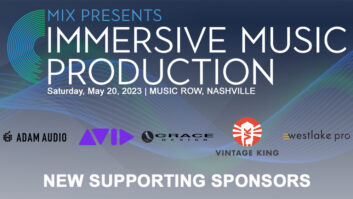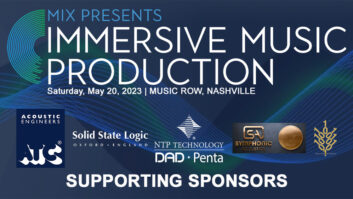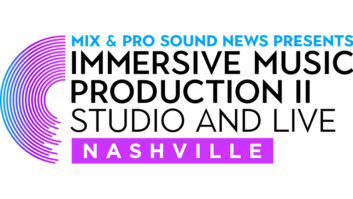Many regular Mix readers are already somewhat familiar with the digital console market. This relatively new but fast-growing segment of the audio industry has been covered in earlier features, Field Tests and Technology Spotlights. But as with all things digital, the faster, cheaper, better rule means that digital consoles are constantly revised and updated, and new products continue to come on the market, often offering enhanced capabilities at a lower price. That creates more opportunity for potential purchasers to find a product that meets their needs, but it also makes it harder to keep up with the latest developments. Therefore, whether it’s a completely new model (or one that’s finally shipping!), a software revision that adds new features or possibly a new hardware option (a channel expander, for instance, or 5.1 monitoring capability), we’ve asked 17 different manufacturers to tell us what they’ve been up to so that we can pass the news along to you. The news we uncovered pertains to consoles designed for music recording and post-production applications; live mixers are not included. We’ve split information into under/over $25,000 sections to help you find the product that best matches your budget.
CONSOLES OVER $25,000
Amek (www.amek.com)
A fully modular digital mixing system with versions tailored for music and post-production, the Amek DMS is available with up to 96 channels at 24-bit I/O, and 32 buses with multiformat panning and monitoring. New for 1999 is the Channel Panel dedicated control surface, which provides control of all channel parameters using 48 rotary encoder pots and 32 switches. Also, Version 3.3 software provides dynamic and snapshot automation with moving faders, a multi-user password and privilege system and a pan/divergence editor.
“The DMS is a mature platform with over 150 systems in operation worldwide,” says director of sales and marketing Wayne Freeman. “Pricing begins at $100,000 for an entry-level, upgradeable platform and tops out at $225,000 for a fully fitted console.”
AMS Neve (www.ams-neve.com)
Libra Post is a new digital audio-for-video console using the same 96kHz-ready processor engine as the company’s flagship Digital Film Console (DFC). “In its three-operator form,” says marketing director Colin Pringle, “DFC is the world’s largest digital console. Libra Post is optimized for the TV/Video post environment and for use by a single mixer. It provides comprehensive post-specific automation through AMS Neve’s Encore automation system, which it also shares with the DFC. Full surround busing and monitoring are provided from a dedicated monitor panel, while machine control and optional joystick panners complete the package.”
Libra Post is available in sizes ranging from 12 to 192 inputs, with 48 buses and multiple stems up to eight channels wide. Options include AMS Neve’s TDIF-MADI converter to enable use of low-cost MDMs with the MADI-based console. Prices for Libra Post start at $250,000.
Fairlight (www.fairlightesp.com.au)
Enhancements to Fairlight’s FAME console were unveiled at April’s NAB show in Las Vegas, including the availability of extended frame sizes of up to 48 motorized faders (available in groups of eight) and a new optional smart key macro panel with 12 individually programmable macro keys supporting up to 144 macros. “We also announced our upgrade to FAME 2,” says John Lancken, CEO of Fairlight USA, “increasing the number of available mix buses and live inputs to 24 each, with 32 digital and analog I/Os. FAME 2 also has a built-in 24-track MFX3+ editor.”
Software enhancements in the new Version 2 software for FAME, Lancken says, include support of dynamics on all mix buses, addition of an external stereo input on FAME’s monitor section (for monitoring left-right feeds post Dolby insertion), frame-accurate punch-ins from preview to write modes, new automation modes including auto take over and automation of outboard signal processing gear.
Harrison (www.glw.com)
Harrison’s new digital.engine is a digital signal processing core designed for retrofit to existing SeriesTwelve and MPC control surfaces, converting them into digital or hybrid mixing consoles. “Our 40-bit SHARC DSP chip gives us the power to process 576 full channels of audio,” says marketing director Stephen Turley, “with 1,344 inputs and 1,344 outputs, 136 console-wide summing buses and full monitoring facilities. This architecture provides dedicated channel processing, with no shared or allocated resources. Every channel contains complete dynamics processing, 4-band parametric EQ, highpass and lowpass filters, 32 aux sends, and panning facilities supporting all surround formats via 72 main recording buses and 24 reassign buses. And a proprietary, PCI-based I/O and communications system provides effective control of our control surface architecture and automation systems.”
Otari (www.otari.com)
“The big news at Otari is the shipping of our first Advanta Digital Production Systems, which feature 24-bit/96kHz capability and surround sound panning and monitoring,” says the company’s Kris Jackson, console products manager. “VRT National Flemish Radio & Television in Belgium has purchased four and taken delivery of two of the Broadcast Production versions of the Advanta.”
Advanta, available in configurations ranging from 32-input, 24-bus to over 128-input, 48-bus, is priced starting at $200,000. “We are also adding to the family of Advanta options by introducing a 19-inch Rack Options section, RADAR II Remote, DK Phasemeter Interface, Group Master Fader Panel, MADI I/O, and System Sync Card,” says Jackson. “And due to release this fall is the Advanta Music Production System, which is currently in Beta.”
Solid State Logic
(www.solid-state-logic.com)
“To SSL, every customer has different requirements,” says Niall Feldman, marketing development manager. “So the physical arrangement and accompanying options of our digital console products vary enormously, because the features and discrete control surfaces are designed for their specific market segments and applications.”
The latest in SSL’s targeted digital console line is the Axiom-MT, a large-format multitrack production console with more than 200 automated mix inputs, 48 multitrack mix buses, 12 main mix buses and a 5.1-channel monitoring section. For film and post-production applications, SSL has upgraded its Avant digital console with a new processing option for more than 1,000 audio paths, for more than 380 inputs, 64 main mix buses, 64 tape returns, 48 pre-dub buses, 24 aux outputs and 192 insert points. And for broadcast production, the Aysis-Air has been enhanced with support for up to 96 fully featured channels, new 5.1 surround sound monitoring features, and delay options for both channel feeds and subgroup outputs.
Sony (www.sony.com/proaudio)
The Sony OXF-R3, known as the Oxford, features 108 channels (12 of which are stereo), 48 multitrack buses, 24 aux send buses and eight stereo subgroups. According to Pro Audio marketing manager Terry Murphy, “There are many configurations available to optimize a system, from a tracking environment requiring many microphones to a 5.1 mix configuration that might be heavily interfaced to digital or analog outboard equipment. These configurations can range in price from $650,000 to $750,000.
“A number of new features,” Murphy says, “have been introduced since last summer, with more to come in the upcoming Version 2.0 release this summer. There is an increase in the number of ‘full’ channels from 72 to 96, the addition of three new EQ types and two new compressor types, new automated motorized joysticks, Multi Record Stem capability, MIDI capability and extended dynamic automation. With Version 2.0, the console will offer a remarkable range of EQ and dynamics processing, including five equalizers and four dynamics processors individually selectable on a channel basis. This range includes new ‘plug-in’ options available for emulation of the GML-8200 EQ and GML-8900 compressor.”
Soundtracs (www.soundtracs.co.uk)
The DPC-II digital production console is designed to serve “post, film and music production markets,” says product manager David Gibbons. “The console features full rather than allocated processing on all channels, a touchscreen-controlled user interface, a 16- to 96-fader control surface, a 160-channel fixed-size engine, 24-bit conversion and 96kHz capability.” Soundtracs says that 50 DPC-IIs had been sold worldwide with two consoles recently going to Howard Schwartz Recording in New York City.
Sizes for the DPC-II range from 16 to 96 faders, with or without patchbay. The console processes 160 channels, with 224 inputs/outputs through I/O-matrixed racks, and 40 buses. New software adds or upgrades areas such as track arming, studio feeds, automation scope, console split, monitor matrix, undo/redo, 5.1 panning, dynamics linking and multifader ganging. Price depends on configuration.
Unveiled in prototype form at April’s NAB show in Las Vegas and slated for mid-summer release, Soundtracs’ new DS-3 is a digital console based on the DPC-II architecture, but in a smaller-footprint version designed for medium-sized post facilities and “second” rooms in larger studios. As shown, the DS-3 is available in a 48×32 (analog I/O) configuration, with 24 digital I/Os for inputs and buses in AES/EBU format. Standard amenities include 5.1 surround panning and a 32×8 matrix providing routing of any combination of channels or stems to the buses for flexible monitoring. Other features include 6-band EQ, compressors and gates on all channels, and 30-segment LED metering. All communication from the controller surface to the I/O racks is via MADI, while all the console DSP circuitry is located within the console stand. The interface follows the DPC-II model-although slightly scaled down-with three high-resolution touchscreens, 24 moving faders and total dynamic automation of all console functions.
Studer (www.studer.ch/studer)
Targeted toward audio post, broadcast and mix-to-picture environments including both film and video, the D950 Digital Mixing System is based around a DSP architecture that allows completely customized configuration by the operator using a Windows NT Configuration Tool (supplied). An internal digital router with stored patch snapshots eliminates the need for external patchbays, and supports interfacing of hundreds of analog and digital signals (either AES/EBU and/or MADI). The console supports “greater than 250” I/Os, with 24-bit I/O word-length, and 48 multitrack buses at 40-bit floating-point internal resolution. Pricing starts at $300,000.
At the recent AES show in Munich, Studer announced that it had sold 26 D950s in the first 15 months of availability and unveiled a major software upgrade for the mixer. According to the company’s product manager for digital consoles, Rudy Kisejak, the new Version 2.0 software adds “comprehensive project management facilities, advanced control group functionality, improvements in the acclaimed Virtual Surround[superscript]TM Panning (VSP) package, advanced channel strip assignment and refinements that simplify the operation of the console.” Other V2.0 enhancements include the capability to split the desk for two-operator mixing, new Dolby EX and 7.1 surround capability, variable LFE (Low Frequency Effects) and center-channel feeds on each channel. Each channel also provides automatable VSP room simulator effects, and unique DSP-based simulations of XY/ORTF/sphere/HRTF stereo miking techniques.
CONSOLES UNDER $25,000
Fostex (www.fostex.com)
Targeted toward project and private studios, the new Fostex VM200 Digital Recording Mixer offers 32-bit processing and mixing for eight analog and eight digital ins (via ADAT optical) and includes S/PDIF out, eight direct bus ADAT digital outs, and eight flexible buses (stereo LR, effects 1/2, aux sends 1,2,3,4). A Cascade mode allows two VM200s to be linked together. Automation facilities include total control via MIDI and a 100-scene memory. The board has 4-band parametric EQ on each of the 16-input channels and uses Fostex’s ASP DSP processors. Retail is $1,499.
“Unlike other digital mixers,” says Fostex’s Budd Johnson, “the VM200 mimics a conventional console in many ways, giving you instant access to often-used features without requiring complicated recall operations. For example, each channel has a dedicated rotary pan control, and a channel’s entire EQ can be accessed via rotary controls.”
General Music
(www.generalmusic.com)
Now shipping, the Falcon digital mixer from LEM by General Music features 40-bit internal processing, 20-bit ADCs/DACs, 12 inputs (six mono mic/lines, two stereo channels and a stereo digital input switchable to AES or S/PDIF), four aux sends (two with DACs for connecting to analog outboard gear), 128-scene snapshot recall, dynamic MIDI automation, 3-band parametric EQ, two internal processors (reverb and effects), AES and S/PDIF outputs, motorized master fader and a digital cascade function for linking multiple Falcons. A backlit LCD shows mixer status/EQ curves/reverb parameters/etc. MIDI Machine Control of external recorders/workstations is standard and includes transport controls, track arming and eight locate points. Retail is $1,495. An optional Lightpipe interface card adds eight additional I/Os for ADAT recorders, as well as a second DSP processor (doubling the number of available effects) for a total of 18 inputs and 16 outputs.
Mackie (www.mackie.com)
Mackie’s Digital 8*Bus has been upgraded with the release of Version 2.0 Real Time Operating System software. “The software architecture of the D8B enables us to implement new customer suggestions on a regular basis,” says digital technology product manager Bobb Haskitt, “so we’ve been able to implement lots of customer requests.” Theadditions include a new graphic automation editor, four user-selectable EQ types, solo latch, solo isolate, surround bus solo isolate, record safe and a new channel overview window. Version 2.0 also offers input, output and reduction metering for compression and gating, as well as the capability to link multiple consoles.
Panasonic
(www.panasonic.com/proaudio)
Panasonic’s new MAX software package for Macintosh and Windows computers is designed to expand the automation and memory capabilities of the WR-DA7 Digital Mixer for use in music, film, audio post and broadcast production applications. The WR-DA7 is an 8-bus digital console with 20 channel strips supporting up to 38 inputs. The $4,995 console features 24-bit A/D converters, six aux sends and receives, and both dynamics and 4-band parametric EQ on each channel, with simultaneous output to +4 balanced analog and switchable AES-S/PDIF digital.
MAX takes advantage of a recent free upgrade (Version 1.2) to the WR-DA7 software, which now supports bidirectional MIDI communications with external controllers and digital audio workstations. According to Panasonic’s David Oren, MAX allows the WR-DA7’s automation to be controlled from an external computer, and for console parameters to be viewed on the computer’s display. At press time, MAX was due for early summer release at $495.
Roland (www.rolandus.com)
Roland has two new series of digital consoles, announced at Winter NAMM and about to ship as of this writing. The VM-7000 Series mixing system features up to 94 input channels, 40 XLR/line inputs with 24-bit A/Ds and phantom power, 24 Fader Groups, support for surround sound mixing, and onboard scene, snapshot and dynamic automation. “The series uses a modular design with separate console and processor,” says Tom Stephenson, manager of recording and mixing products. “That means it’s no longer necessary to have the console and the I/O interface in the same room, which makes wiring a studio much easier. A system can have one or two consoles and one or two processors.”
Console/control surface prices range from $2,995 to $3,695, while processor/IO modules range from $1,995 to $2,795.
The VM-3100 Series mixing stations, meanwhile, start at $995 and feature 24-bit A/D converters, eight mic ins (two XLR with phantom power), four additional line inputs), eight buses, two compressors, one or two stereo FX processors, 16 MIDI faders, transport controls and scene automation. The $1,295 VM-3100Pro also includes eight channels of MDM or other expansion box interface, as well as COSM Speaker Modeling.
Spirit (www.spiritbysoundcraft.com)
Spirit is “preparing to launch” Version 1.5 software for the $4,999 Digital 328 console (currently V. 1.1), which features ADAT, TDIF, AES, and S/PDIF digital inputs, 16 UltraMic preamps, 16 line inputs and five stereo inputs. Outputs include TDIF, AES and S/PDIF. MIDI (used for snapshot and dynamic automation of all parameters) and word-clock I/O are also supported, as are Sony 9-pin control and SMPTE timecode input. Three optional interface boxes (AES/EBU, analog RCA and Mic/Line) are available to allow connection of additional inputs and/or outputs via the 328’s two TDIF ports.
The free “major upgrade” software revision includes FX cascading, added Dynamics memory locations, 32-channel MIDI control, 64 MIDI controller memory locations, sync to Superclock (256-x word-clock), true stereo grouping and automatic switching from external to internal word-clock if the external clock source becomes invalid. On the hardware side, Spirit’s new Mic/Line Interface has eight additional balanced analog mic preamps/line inputs (with LED meters, analog insert jacks and direct outputs) and onboard 24-bit A/D converters that interface via the 328’s TDIF ports. Particularly suited for live sound applications, the two-rackspace interface retails at $649, and two units can be combined to add 16 more analog inputs to 328.
Tascam (www.tascam.com)
Tascam’s digital console line is set to expand to three models with shipment this month of the new TM-D4000, a 32x8x2 digital mixer with 4-band fully parametric EQ, dynamics on each channel, surround sound panning (via bus 1 through 6), and 24-bit converters on analog I/Os, stereo master and monitor outs. Priced at $4,299, the console comes with eight analog ins and has slots for optional TDIF, ADAT, AES or analog inputs on channels 9 through 32 (at prices ranging from $199 to $499). The console also supports MIDI in/out/thru, and up to four may be cascaded. Snapshot automation is included; dynamic automation is available with an external host PC.
Shipping since September 1998, the $1,299 TM-D1000 is a 16-channel digital board (1-8 analog, 9-16 TDIF) supporting four groups, four aux buses, four XLR inputs with phantom power, two AES or coaxial digital outputs, one AES or coaxial digital input, digital dynamics, stereo effects, and a 128-scene snapshot memory with front panel or MIDI recall.
Yamaha (www.yamaha.com)
Yamaha’s digital console line remains stable with three models, the 01V, 02R and 03D. But the company has introduced the MY4-AD, a new 24-bit A/D conversion card for the 02R and the 03D, with user-switchable in/out levels (-10, +4 or +10). “We are very pleased to offer this new card,” says national sales and marketing manager Larry Italia, “because our customers will now be able to take advantage of the 24-bit in/out word-length capability of the 02R and the 03D.” The MY4-AD retails for $249.







